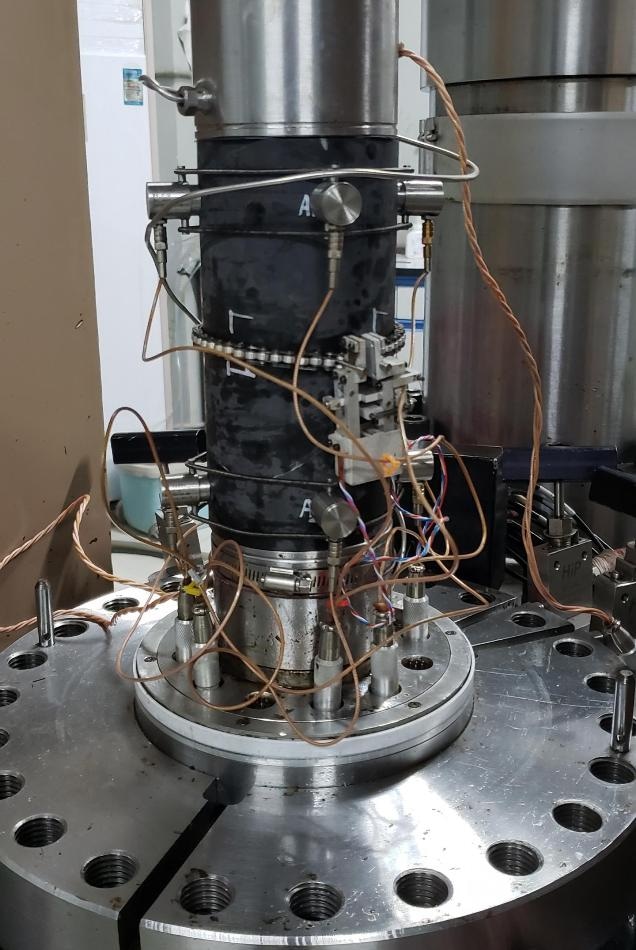May 31 2019
Researchers from the Chinese Academy of Sciences and China University of Petroleum (Beijing) have reported that CO2 could be a better hydraulic fracturing (fracking) fluid compared to water.
 This image shows a shale sample ready for fracturing with CO2. (Image credit: Xuehang Song)
This image shows a shale sample ready for fracturing with CO2. (Image credit: Xuehang Song)
Their study, reported on May 30th, 2019, in Joule, could lead to a more environment-friendly form of fracking that can facilitate a dual method of capturing and storing atmospheric CO2.
Fracking is a method used for obtaining resources from unconventional reservoirs where fluid (generally water mixed with foaming agents, sand, biocides, and other chemicals) is injected into the rock to fracture it to liberate the resources within. Of the nearly 7–15 million liters of fluid injected, between 30% and 50% remains in the rock formation following the cessation of extraction. Its environmental threats, increased water consumption, and frequent production problems have resulted in concerns about fracking among environmental supporters as well as industry experts.
Non-aqueous fracturing could be a potential solution to circumvent these issues. We chose CO2 fracturing from a range of options because the process includes multiple benefits. However, we were still lacking a fundamental understanding of the technology, which is greatly important for its further development and deployment.
Nannan Sun, Researcher, Shanghai Advanced Research Institute, Chinese Academy of Sciences
The advantages of CO2 fracturing are as follows: does not require a bulk water supply (which would render fracking feasible in dry places), decreases the risk of damage to the reservoirs (as is the case usually when aqueous solutions develop blockages in the rock formation), and offers an underground repository for captured CO2.
Yet, there are no chances of commonly using CO2 as a fracking fluid until it turns out to be more effective compared to water at resource production. Sun and his colleagues gathered shale outcrops from Chongqing, China, and fractured them with CO2 and water for the analysis of the differences between water and CO2 as fracturing fluids on a microscopic level. They discovered that CO2 performed better than water, leading to the development of complex networks of fractures in sufficiently higher stimulated volumes.
We demonstrated that CO2 has higher mobility than water, and, therefore, the injection pressure can be better delivered into the natural porosity of the formation. This changes the mechanism by which the fractures are created, generating more complex fracture networks that result in more efficient shale gas production.
Nannan Sun, Researcher, Shanghai Advanced Research Institute, Chinese Academy of Sciences
Although the scientists hope that this hydraulic fracturing method will be scalable, its large-scale development is presently restricted by CO2 availability. The cost of captured CO2, which is obtained from emission sources, is still extremely expensive to make CO2 an industry-wide fracking fluid substitute.
The researchers also observed that once CO2 is injected into the fracture, it gains a low viscosity that prevents it from efficiently transporting sand to the fractures. Since the sand is expected to prop open the fractures when shale gas is harvested, it is important that researchers learn to enhance the viscosity of the fluid—however, they are not yet sure of achieving this at low cost and reduced environmental footprint.
In future, the scientists have decided to investigate the limits of CO2 fracturing method to gain insights into how it can be used.
Further investigations are needed to identify the effects of type of reservoirs, geomechanical properties and conditions, CO2 sensitivity of the formation, and so forth. Additionally, cooperation with industries will be carried out to push forward the practical deployment of the technology.
Nannan Sun, Researcher, Shanghai Advanced Research Institute, Chinese Academy of Sciences
This study was financially supported by the Strategic Priority Research Program of the Chinese Academy of Sciences, CAS Key Lab for Low Carbon Conversion Science and Engineering, and National Natural Science Foundation of China.